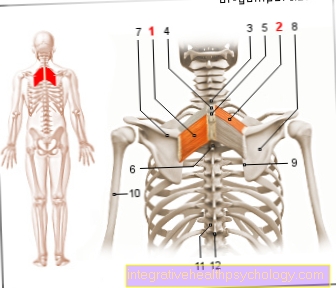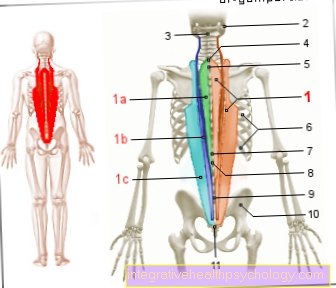Agranulocytosis - what are the causes?
Synonyms in a broader sense
Granulocytopenia

What is agranulocytosis?
In so-called agranulocytosis, there is an almost complete lack of granulocytes. The granulocytes belong to the white blood cells (Leukocytes) and are responsible for defense against infection. When an infection begins or the bone marrow is damaged, the number of granulocytes may decrease. This is then known in technical terms as granulocytopenia. As a result, the body's defenses are now lowered and the susceptibility to infection is increased. Agranulocytosis is the extreme form of this condition.
Read more on the subject at: White blood cells
These are the causes of agranulocytosis
Three different forms can be distinguished in agranulocytosis. In general, a distinction is made between the congenital, very rare agranulocytoses and the more common acquired type I and type II agranulocytoses.
Congenital agranulocytosis is also known as Kostmann syndrome and is a disease in which there are fewer or no granulocytes (more precisely, neutrophils, a subclass of white blood cells) present at birth. The cause lies in a gene mutation, which ultimately leads to the maturation disorders of the white blood cells, i.e. not enough mature granulocytes are formed.
In the type I reaction, the body's own immune processes are directed against the granulocytes and destroy them. On the other hand, the granulocyte deficiency in type II is based on a deficiency in formation, which is often triggered by substances that damage the bone marrow. Type I can therefore be more sudden (acute) occur as Type II, which gets worse over time.
There are many different ways in which granulocyte counts can be severe.
Agranulocytosis can be caused by intolerance to some medications such as against certain painkillers (Analgesics) such as. Novalgin® (metamizole), antipyretic drug (Antipyretics), against drugs that inhibit thyroid function (Anti-thyroid drugs such as thiamazole and carbimazole), against so-called neuroleptics for the treatment of mental illnesses or certain antibiotics (sulfonamides, cephalosporins, metronidazole).
In addition, through the use of a cell-killing therapy using so-called cytostatics, e.g. In the form of chemotherapy, the granulocytes will drop.
Furthermore, disorders of the blood formation in the bone marrow are the cause of agranulocytosis.
diagnosis
In addition to the medical interview (anamnese) about the course of the disease and recent medication intake, the investigation mainly the lymph nodes and mucous membranes play an important diagnostic role.
The most important means of diagnosing agranulocytosis is a laboratory blood test. The so-called complete blood count plays a decisive role here.In this, the various white blood cell subclasses, to which the granulocytes also belong, are measured separately in terms of their frequency. The decrease in granulocytes (less than 500 cells / microliter blood) can now indicate agranulocytosis. In addition, the determination of other blood values to rule out other diseases (differential diagnosis) is very important.
Read more on the subject at: Blood test
There is also the option of a so-called bone marrow puncture, in which a small bone marrow sample is taken from the bone ridge and examined for a blood cell formation disorder. This examination is carried out under a microscope with the help of different staining of the sample, through which, among other things, various (surface) features of the cells are made visible, and is usually carried out by a pathologist.
Symptoms of agranulocytosis
As a rule, agranulocytosis leads to a restriction of the general condition with a severe feeling of illness (fatigue, headache, malaise, muscle pain). Chills, fever, nausea and a racing heart (Tachycardia) occur. Since the immune defense is weakened by the drastic decrease in granulocytes, pathogens such as B. Parasites, bacteria or fungi are no longer adequately combated. The consequences are inflammation and infections in many parts of the body. In the further course the occurrence of tonsillitis (Tonsillar angina) and mouth rot (Aphthous stomatitis) possible. The three typical clinical signs of agranulocytosis are fever, tonsillitis, and oral rot.
How is agranulocytosis treated?
Since in most cases agranulocytosis results from drug side effects, a potentially causative drug must first be identified and the doctor discontinued it as soon as possible. However, there is also the possibility that no triggering drug can be found. In these cases, but also in the case of a side effect of a drug, stimulation therapy for granulocyte production should be carried out. There is the option of giving a so-called granulocyte growth factor (e.g. granulocyte colony stimulating factor = G-CSF). This growth factor is a hormone that is normally released by the body when there is inflammation and accelerates the formation of immune cells (granulocytes).
In addition, anti-infectious therapies should be initiated, as the defenses are very weakened by the lack of granulocytes and infections often develop.
prophylaxis
First of all, medical advice is of great importance when prescribing drugs that may trigger agranulocytosis. Furthermore, the patients should be informed that after they have already gone through agranulocytosis, a renewed fall of granulocytes in the blood is possible or likely when taking certain medications.
Through good hygiene measures in the throat and mouth and in the anal region as well as by avoiding sick people and many people, infections during an existing agranulocytosis can be contained or even partially prevented.
forecast
The prognosis can vary depending on the underlying cause of the agranulocytosis. However, it can be said that the acute phase of agranulocytosis is the most complicated and dangerous time.





























